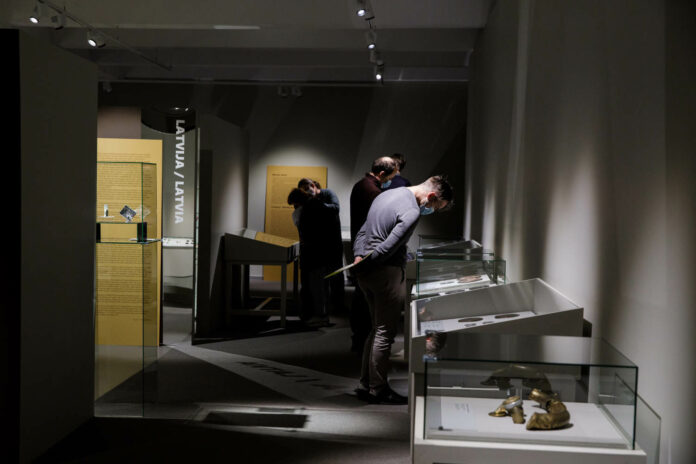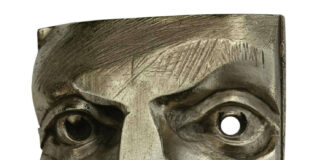The medal is perhaps one of the most niche objects in the history of art, receiving more attention from historians as a perpetuator of one or another important historical event, than an art critic. At present, medallic art also often remains on the periphery of the attention of the latter, and of society as well, and it’s a pity. Although it is one of the smallest forms of art, it usually contains impressive content. This is exactly what medalists from various countries have been trying hard to prove for many decades, working patiently to promote this genre and immortalizing history in metal.

History of the medal dates back to ancient times, when the ancestors of the medal, the medallions with portraits of emperors in the Roman Empire, were awarded to the leaders of the barbarian tribes loyal to Rome. Thus, the Roman concept of the medallion was little different from ours: both then and now, the medal was an object with a peculiar canonical form of memorial and artistic value, intended to reward, honor, or mark a significant person and event. Lithuania became acquainted with medals late, as well as with many other forms of art – only in the 16th century, when German, French, Czech, Italian and Flemish medal schools were already flourishing in Western Europe. The first Lithuanian medal is associated with the King of Poland and the Grand Duke of Lithuania Sigismund the Elder, in 1520. He ordered a medal to mark the birth of his son Sigismund Augustus. It was this event that became the main theme of the XI Baltic Medal Triennial. This triennial of medals, in turn, is another testament to the perseverance of medalists.
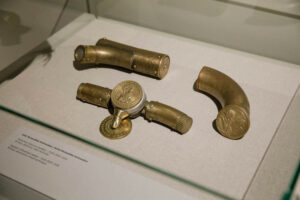
The art of the Lithuanian medal, if we jump from the Renaissance to the near future – in the first half of the 20th century, was mostly associated with the work of Petras Rimša, and later – Juozas Zikaras. Prior to World War II, medals were created by only a few artists. Later, however, that barely smouldering bonfire began to burn more and more brightly, and in the year 1985 a separate section of medal artists has been established in the Lithuanian Artists’ Union. The annual symposiums of medal art in Telšiai started in the same year and still are live today. The triennial of Lithuanian medals was also organized, each of which became an extremely important event for the community of medalists.
This is also the case with the XI Baltic Medal Triennial, a large-scale international event that clearly demonstrates the situation of medal in the countries of Baltic region and undoubtedly proves the importance of international co-operation. When the medal artists gathered for the eleventh time, you can see in one exhibition space what is going on in contemporary medal art and how the works of Lithuanian, Polish, Swedish and Latvian medal artists differ. This time, many things impress from the viewer’s point of view: a structured concept, solid partners, a sufficiently clear selection and, above all, the location of the triennial. From St. John’s street gallery, the XIth Baltic medal Triennial has moved to the spaces of the National Museum of Lithuania, the New Arsenal. St. John’s street gallery has been a bastion for a long time (since 1991 it has even been called the Medal Gallery for some time). Such a change of location shows the triennial’s move towards solidity – the National Museum, as an institution, really adds value to any exhibition on its premises. The partners of the Triennial strengthen the impression of solidity – the Polish Institute in Vilnius, the Toruń Museum, the Nicolaus Copernicus University in Toruń, the Polish Medal artists’ Association, and an educational program – six video lectures by Lithuanian and Polish researchers covering a wide range of topics. The curator (and participant) of the Triennial, Lina Kalinauskaitė, did a really great job of lifting the event up to the museum level (and at the same time probably making a commitment not to let the cartel down in the upcoming triennials, but that is the story of the future). The choice of partners also presupposed the traveling nature of the exhibition: before settling in the LNM, the triennial was exhibited at the Toruń Regional Museum, located in the former town hall and the John Paul II Coin and Medal Museum in Częstochowa. Everything sounds really solid, as befits an event that is ongoing almost for 40 years. Everything is solid as well as the triennial exposition in the New Arsenal, which cleverly allows to see not only the obverse of the medal, but also the reverse reflected in the mirror, which is extremely important for the medals (the architect of the exposition is Giedrė Narbutienė).
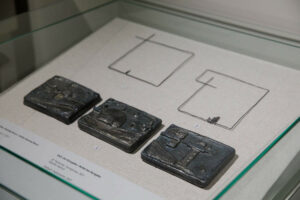
The restrained, correct, elegant space is divided into four merging spaces according to the countries involved; Such a territorial principle unequivocally invites not only to review the medal situation of each country – Poland, Lithuania, Latvia and Sweden – but also to be reluctant to compare the artistic, stylistic and social features of our and our neighbors’ medal art.
The medal is a complex object for their creators: in a small confined space they have to accommodate the symbolic and cultural value of the object to which this distinctive sign is awarded, to create a metal miniature, without forgetting the artistic value of this miniature. Sometimes, the creators of medals probably explode inside out of a desire to step outside the circular or rectangular frames, extend the medal, break it, or delete it. From this desire, medals probably emerge, moving on to objects, losing their boundaries, spilling over the edges and asking the viewer more questions than answers. However, there are authors who feel comfortable in the field of a classic medal all their lives, like in an elegant suit, and don’t break anywhere out of it. The 11th Baltic Medal Triennial presents a very wide panorama of medals; if it were necessary to answer the question – what is a medal, I do not think it would be easy for the respondent to formulate a definition of a medal on the basis of this exposition. The medal is treated very widely in this triennial, both in terms of topics and, above all, in terms of form. Although the main theme, as I mentioned at the beginning of the text, is 500 years after the creation of the first medal in Lithuania and Poland, the concept of the triennial allows to include in the exhibition all medals created by the authors in the last 3 years time period, whatever their topics. This allows to significantly expand the overall visual outline of the exhibition, and at the same time, in addition to the thematic diversity, to present a kind of “average temperature”, the opportunity to see what has emerged in the medal barracks in the last three years. Thus, a viewer looking for relief for Sigismund Augustus should not be disturbed by finding a medal for the first day of spring (author Hanna Jelonek), a tsunami remembrance (Iwona Langowska), or a light of the beetles (Antra Urtane) next to the king.
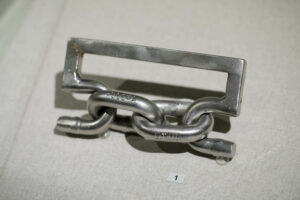
Still, the main theme, i.e. the half-thousand-year anniversary of medal art, has inspired a number of authors. One of the most impressive is the medal of the Polish author Sebastian Mikolajczak, who is rude, rude, but tells everything all at once, as if tearing out the number 500 from the circle of the medal and embossing the Lithuanian knight and the Polish eagle into zeroes (as medals), thus creating a kind of metamedal. Petras Baronas (Lithuania) depicts the delicate plasticity of the mother queen holding the newborn son, with almost no indication of any royal regalia, rather concentrating on the subtle transmission of the mother‘s tenderness to the baby. Daumantas Kučas emerges from the framework of the classical concept of a medal, creating a generalized Renaissance building with arched windows with Barbora and Sigismund’s profiles. The plaque shape of Gediminas Žuklys is associatively associated with the Renaissance altar or configuration: the symmetrical composition shows Sigismund the Old and Bona Sforza leaning on both sides of the baby.
However, many authors are tempted to exhibit both “free themes” and free-form works. A total of seventy artists take part in the XIth Baltic Medal Triennial, and almost half of them present medals that go far beyond the classical circle, and there is already room for a long discussion on what is now generally called a medal, which still fits into the concept of a medal, and which has long since moved into the field of the medal object or small sculpture. The problem of terms in medal art is obviously very acute, but it is not the subject of this text, but at least of a separate conference, I am relieved. Because I would not like to consider to which genre Aušra Jasiukevičiūtė’s “Vilnius-Krakow”, Stanislav Kosminski’s “Coronation”, Joana Bebarska’s “4… 9… 3” or Andrzej Borcz’s “Country 2-3” and others should be assigned, it would be difficult to mention them all. But this time we rely on the authority and expert knowledge of the curators and agree that everything that is exhibited as a medal is a medal, because the selection of the triennial exhibits lay on the shoulders and responsibilities of four curators – Lina Kalinauskaitė (LT), Janis Strupulis (LV), Kerstin Östberg (SE) and Sebastian Mikolajczak (PL). Polish medal artists seem to have gone the furthest in this imaginary quadruple (as four countries are taking part in the triennial) – their medals look the most contemporary, conceptual and furthest from the classics. At the same time, it is obvious that the Polish Medal School is not experiencing a weakening point and the interest in medal art is very alive. The works are eye-catching with textures reminiscent of abstract paintings with tangible brushstrokes (Maciej Wierzbicki’s Axis), turned into a fragment of the landscape (Hanna Jelonek’s “First Day of Spring”), and makes Hawaii think of the vast space of the human mind. ) or reminiscent of a horrific session of spiritualism (Magdalena Dobrucka’s “Fear”).
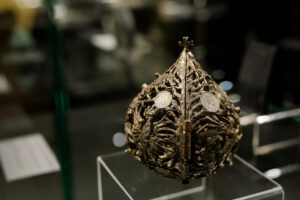
The Polish authors presented a truly impressive panorama of the various forms of the medal, both in terms of form and content. The 15 Latvian artists presenting 32 works also provide an opportunity to see what the neighbors’ medals look like. From the classic circles of Edgars Grinfelds, Andris Berzinš, Janis Strupulis, Inese Natrina medals to the figurative objects more reminiscent in Svetlana Saveljeva’s small sculpture objects. In the general context, Latvians look restrained, calm, like a middle-aged man with a classic raincoat, finding his place, not rushing or being distracted anywhere, but looking a little with longing at the reckless, fearless courageous youth. Relatively the newest participants in the triennial are the Swedish authors. They are only 5, but when did quantity determine art? Kerstin Östberg’s engraved medal with its pearl-encrusted framing is more inclined towards jewelry (“Kotryna Jogailaitė”), Gustav Hedengren Wirsen’s unexpected decision reminds us of the medal as a trace in history. One of the brightest and most memorable Swedish medals are the red and blue embossed-faces in Thomas Quarsebo’s diptych “Tell a Story.”
The XIth Baltic Medal Triennial revolved around the Baltic countries. It shows that medal art is alive, reaffirming how versatile a piece of metal can be, and how strong the messages of reflected history can speak-out.
This article was first published on the website of the Vilniaus Galerija.
Although the exhibition has ended, you can enjoy the masterpieces through the catalog of the XI Baltic Medal Triennial.
Learn more about the numismatic center at the heart of Europe – Warsaw.



